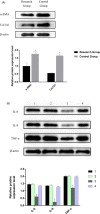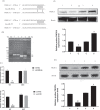Effect of artificial skin membrane on the expression of miR-155 and miR-506-3p in patients with second-degree burns
- PMID: 35949047
- PMCID: PMC9459302
- DOI: 10.1002/jcla.24564
Effect of artificial skin membrane on the expression of miR-155 and miR-506-3p in patients with second-degree burns
Abstract
Objective: To investigate the effect of artificial skin on the expression of miR-155 and miR-506-3p in patients with second-degree burns.
Methods: The study subjects included 50 patients with second-degree burns treated from July 2019 to July 2021. The control group received routine nursing, while the research group received both routine and artificial skin intervention simultaneously. The changes in wound tissue fibrosis and prognosis were observed. The expression levels of miR-155 and miR-506-3p and their downstream regulatory factors were detected and correlated with the rehabilitation of patients after artificial skin treatment.
Results: After treating second-degree burns with artificial skin membranes, the patient's wound tissue fibrosis and inflammation level improved. At the same time, the expression levels of miR-155 and miR-506-3p in related tests were higher than those in patients with available treatment.
Conclusion: The effect of artificial skin membrane on the wound healing of second-degree burn patients may be realized by influencing the expression levels of miR-155 and miR-506-3p and their related signaling pathways.
Keywords: artificial skin; burn; microRNA-506-3p; microRNA155.
© 2022 The Authors. Journal of Clinical Laboratory Analysis published by Wiley Periodicals LLC.
Conflict of interest statement
The authors declare that they have no conflicts of interest.
Figures





Similar articles
-
MiR-223-3p promotes angiogenesis in burn wound healing by targeting FOXO1.J Burn Care Res. 2025 May 15:iraf083. doi: 10.1093/jbcr/iraf083. Online ahead of print. J Burn Care Res. 2025. PMID: 40373170
-
LncRNA XIST promotes extracellular matrix synthesis, proliferation and migration by targeting miR-29b-3p/COL1A1 in human skin fibroblasts after thermal injury.Biol Res. 2019 Sep 20;52(1):52. doi: 10.1186/s40659-019-0260-5. Biol Res. 2019. PMID: 31540582 Free PMC article.
-
MiR-506-3p regulates autophagy and proliferation in post-burn skin fibroblasts through post-transcriptionally suppressing Beclin-1 expression.In Vitro Cell Dev Biol Anim. 2020 Aug;56(7):522-532. doi: 10.1007/s11626-020-00472-3. Epub 2020 Aug 4. In Vitro Cell Dev Biol Anim. 2020. PMID: 32754856
-
Induced pluripotent stem cells-derived microvesicles accelerate deep second-degree burn wound healing in mice through miR-16-5p-mediated promotion of keratinocytes migration.Theranostics. 2020 Aug 8;10(22):9970-9983. doi: 10.7150/thno.46639. eCollection 2020. Theranostics. 2020. PMID: 32929328 Free PMC article.
-
miR-24-3p obstructs the proliferation and migration of human skin fibroblasts after thermal injury by targeting PPAR-β and positively regulated by NF-κB.Exp Dermatol. 2022 Jun;31(6):841-853. doi: 10.1111/exd.14517. Epub 2022 Jan 6. Exp Dermatol. 2022. PMID: 34932851
Cited by
-
Exosomes and microRNAs: insights into their roles in thermal-induced skin injury, wound healing and scarring.Mol Genet Genomics. 2024 Sep 25;299(1):89. doi: 10.1007/s00438-024-02183-w. Mol Genet Genomics. 2024. PMID: 39317785 Review.
-
Construction of lncRNA- and circRNA-associated ceRNA networks in the prostatic urethra of rats after simulating transurethral laser prostatectomy (TULP).Mol Cell Biochem. 2024 Jun;479(6):1363-1377. doi: 10.1007/s11010-023-04804-1. Epub 2023 Jul 6. Mol Cell Biochem. 2024. PMID: 37410211 Free PMC article.
-
Identification of ferroptosis-related genes and predicted overall survival in patients with burns.Front Surg. 2023 Jan 9;9:1060036. doi: 10.3389/fsurg.2022.1060036. eCollection 2022. Front Surg. 2023. PMID: 36700031 Free PMC article.
References
MeSH terms
Substances
LinkOut - more resources
Full Text Sources
Medical

